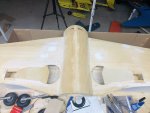First things first for this update: Safety first!

Since I knew what structure was underneath the removal of the other side went much better and less destructive than the first side. The wheel hole was cut out and trimmed with the dremel sanding drum.


I removed additional balsa skin to facilitate installation of the ply plates and did dry fitting and fine shaping of the plates to help them fit better.

From here we proceed to mix up epoxy. This is my 60-minute epoxy as it cures out harder than 5 or 15 minute epoxies. Previously I had cut additional hard wood that fit very snug against both ply plates. You can see my strategy more clearly in the first image below. The procedure was to apply epoxy to the plates and install them, then install the newly cut hardwood as a means to apply pressure to the plates against the ribs, then install the original hardwood beams on top to tie it all together. To clap the top beams in their place, I cut off a piece of paint stick to wedge in to apply clamping pressure to the beams in the side direction. These are temporary until the epoxy cures.



The epoxy should be cured out enough by this afternoon/evening for me to proceed on to replacing the skin and cutouts for the retract unit mounting. Additional shaping of the wing tips and spackle filler will be on the list next. Then rinse and repeat the glassing process.

Since I knew what structure was underneath the removal of the other side went much better and less destructive than the first side. The wheel hole was cut out and trimmed with the dremel sanding drum.


I removed additional balsa skin to facilitate installation of the ply plates and did dry fitting and fine shaping of the plates to help them fit better.

From here we proceed to mix up epoxy. This is my 60-minute epoxy as it cures out harder than 5 or 15 minute epoxies. Previously I had cut additional hard wood that fit very snug against both ply plates. You can see my strategy more clearly in the first image below. The procedure was to apply epoxy to the plates and install them, then install the newly cut hardwood as a means to apply pressure to the plates against the ribs, then install the original hardwood beams on top to tie it all together. To clap the top beams in their place, I cut off a piece of paint stick to wedge in to apply clamping pressure to the beams in the side direction. These are temporary until the epoxy cures.



The epoxy should be cured out enough by this afternoon/evening for me to proceed on to replacing the skin and cutouts for the retract unit mounting. Additional shaping of the wing tips and spackle filler will be on the list next. Then rinse and repeat the glassing process.




















